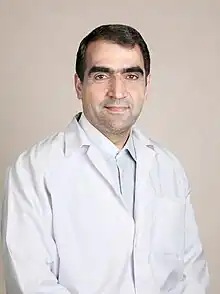
Introduction
Seyed Hassan Ghazizadeh Hashemi (Persian: سید حسن قاضیزاده هاشمی; born 21 March 1959)[1] is an ophthalmologist and full professor at Tehran University of Medical Sciences, [1] as well as the head and founder of the Noor Ophthalmology Complex.[2]
During his career, Hashemi has initiated the first Eye Cohort Study in the Middle East (Shahroud Eye Cohort Study – since 2008) and was one of the founders of Jihad Sazendagi (an organization established after Iran’s revolution to serve the rural residents and underserved regions).[3] He has also established Nooravaran Salamat Charity Foundation (2001) which provides free general and specialty ophthalmic and dental services in remote underprivileged areas of Iran.
Hashemi was elected as the Minister of Health, Treatment, and Medical Education in 2012 and resigned from this position in January 2017. Among his numerous services, while in office, is developing the national Health Transformation Plan.[4]
Early Life & Education
Hashemi was born in March 1959 in Fariman (Khorasan Razavi Province), where he completed his primary education. He completed his secondary education at Danesh Bozorg-nia High School in Mashhad. He was accepted into medical school at Ferdowsi University in Mashhad after taking the national entrance exam of 1976 – 77. In 1989, he completed his residency training in ophthalmology at the same university, ranking first among his cohort, and in 1990, he completed his fellowship in Cornea and Anterior Segment at Shahid Beheshti University of Medical Sciences in Tehran. He has also completed numerous post-graduate training courses in North America and Europe on the latest methods of corneal surgery, cataract surgery, and correction of refractive errors.
Career
After graduation, Hashemi spent more than 30 years at Tehran University of Medical Sciences and Farabi Hospital. During his academic tenure, he has trained a large number of medical and allied health students, including more than 200 ophthalmologists and 50 anterior segment fellows. He has also organized numerous training courses for ophthalmologists in the past three decades.
In May 1992, he established Noor Eye Clinic (the very first private-sector ophthalmology clinic) in Motahari Street, Tehran. In 2006, he established Noor Eye Hospital on Esfandiar Boulevard, Tehran. Now, Noor Ophthalmology Complex comprises 2 hospitals, 4 clinics, and sub-specialty polyclinics in Iran and Oman, all of which are run under his close supervision.
Driven by his dedication to science and discovery, Hashemi founded Noor Ophthalmology Research Center, which was granted approval from the Ministry of Health, Treatment, and Medical Education in 2010. The center has carried out numerous scientific investigatins and research projects under his supervision. To date, Hashemi has published more than 450 articles in leading high impact factor journals (Google Scholar link: Hassan Hashemi - Google Scholar). According to the Web of Science, he ranks among the top 50 people in the field of ophthalmology and among the top 30 people contributing to the field of collagen cross-link, which is a novel technique to prevent the progression of keratoconus.
Some of his regional and national research projects include the Shahroud’s Eye Cohort (14 years old now), Tehran Eye Study, Tehran Geriatric Eye Study, Iranian Cataract Surgery Survey, Visual Impairment in Rural Iran Study, and Evaluation of Children’s Vision Screening Programs in Iranian.
As a leading ophthalmic surgeon and pioneer in adapting modern techniques, Hashemi has been the first in Iran to perform and promote countless modern therapeutic devices and surgical techniques, some of which include:
1. Sutureless phacoemulsification cataract surgery
2. Laser refractive surgery techniques such as LASIK
3. Laser-assisted cataract surgery with Nd:Yag and Femtosecond lasers
4. Micro-incision cataract surgery
5. Glaucoma drainage devices such as single and double-plate Molteno implants, Ahmed glaucoma valve, and Baerveldt EX-Press shunts
6. Viscocanalostomy and deep sclerectomy
7. Lamellar keratoplasty using Melles’ DALK technique and Anwar’s big-bubble technique
8. Posterior corneal grafting using the Melles, PLK, DSAEK, DMEK, and DWAK techniques
9. Automated lamellar therapeutic keratoplasty (ALTK) and laser-assisted full-thickness and lamellar keratoplasty techniques
10. Intracorneal inlays of various types
11. Various types of accommodating intraocular lenses, multifocal ReSTOR, multifocal Array, C&C Vision AT-45, Artisan, Artiflex, and ICL IOLs.
12. Various types of intracapsular rings and Artisan IOLs for the management of subluxated nuclei
13. Intraocular lenses (IOLs) for correction of myopia and hyperopia
14. Refractive surgery using wavefront customized ablation technology
15. Conductive keratoplasty
16. KeraRing and INTACS intrastromal corneal ring segments
17. Phototherapeutic keratectomy for correction of corneal opacities
18. Automated lamellar keratoplasty for correction of myopia and hyperopia
Honors
According to Stanford University statistics of 2021, Hashemi is among the top two percent of scientists in the world.
He has been nominated as an ASCRS Top Researcher in 2019 and 2020.
He also ranked the first in Iran Ophthalmology Board exam (1989) and was among the first 3% of medical graduates (1985).
He was awarded the rank of the Best Researcher at the 14th Avicenna Festival (2013), the Best Researcher at the Farabi Ophthalmology Festival (2013), the Best Researcher of the Department of Clinical Sciences Surgery at the 15th Research Festival of Razi Medical Sciences (2014) and the Badges of the Best Scientist, Altruism and prevention of vision loss and the Best Teacher in Shams Farabi Festival (2015). Also, he received the highest honor of the festival and the title of "Physician of Eyes" and wore the "Phoenix Outfit" of the festival, which was introduced for the first time at the Shams Festival.
Banning from gaining temporary residency in Canada
Canadian federal government said it will deny former Iranian health minister Seyed Hassan Ghazizadeh Hashemi temporary residency following reports that he was spotted in Montreal in summer 2023.[5]
References
- 1 2 "Faculty of medicine / Academic staff / Dr Seyed Hasan Ghazizade Hashemi / Public information". Tehran University of Medical Sciences, School of Medicine. Archived from the original on August 20, 2017. Retrieved October 22, 2014.
- ↑ "Q&A: I Came, I Saw". The Business Year International Inc. Archived from the original on October 27, 2014. Retrieved October 27, 2014.
- ↑ "The best and worst of worlds: Tehran's public hospital wards". Guardian. January 28, 2015. Archived from the original on January 29, 2015. Retrieved March 27, 2015.
- ↑ "Biography of proposed minister of health, medicare and medical education". Islamic Republic News Agency. May 8, 2013. Archived from the original on October 22, 2014. Retrieved October 22, 2014.
- ↑ "Federal government banning former Iranian minister from gaining temporary residency". CBC. 2023-08-29. Retrieved 2023-08-30.
External links
- Official website Archived 2014-10-20 at the Wayback Machine

